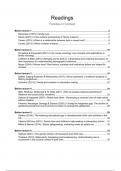Summary
Summary ALL literature Families in Context UVT 2024
- Course
- Institution
A complete summary of all the mandatory literature in the course Families in Context, given at Tilburg University in 2024 by prof. Ivanova. A list of all the summarized titles is on the first and second page of the preview. The summary is fully in English. I also have a summary of all the lectures ...
[Show more]



